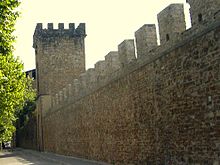City walls of Florence
The city walls of Florence are the curtain walls around Florence that have changed several times in the course of history . Up to six such rings can be distinguished. The last one was from the middle of the 16th century. The walls north of the Arno had to give way to the Viali di Circonvallazione in the 19th century , which remained south of the Arno.
Roman city wall

The rectangular Roman wall followed in the north roughly the Via dei Cerretani to the Cathedral Square, the Via Tornabuoni in the west, the Via del Proconsolo in the east and in the south it followed the course of the Arno. The covered area was about 20 hectares. There were four gates, with the medieval names Porta Aquilonia (in the north), Porta San Piero (in the west), Porta di Santa Maria (south) and Porta di San Pancrazio or Brancazio in the west. The amphitheater and the merchant quarters south of the Arno, which are predominantly inhabited by Syrian traders, were not enclosed by the wall . After the fall of the Western Roman Empire, this wall fell into disrepair.
It is controversial whether a second, smaller ring of fortifications was built after the city was conquered by Justinian's general Narses in 550 . Already in the early Middle Ages there was a massive population growth, which had to be taken into account by expanding the wall ring. This happened from the 9th century (third ring), then from the 11th century about every 100 years: in 1078, then 1173–75 (with the first reaching from the southern banks of the Arno), and at the beginning of the 1280s.
Walling around 1170
The expansion of the 1170s was done in a hurry. It can be read from the urban structure and is attested by chroniclers. However, the archaeological findings are rare and show the use of rather inferior material. It was evidently more of a kind of reinforced palisade .
New wall ring around 1280
At the beginning of the 1280s, Florence had around 80,000 inhabitants and urgently needed a new city wall. Their plan is generally attributed to Arnolfo di Cambio . But Giotto , Andrea Pisano and others also contributed. The area enclosed by the wall grew from 75 to 430 hectares, there were 63 towers and 12 monumental gates, in the north of the city the Mugnone was diverted and a moat was created.
This fifth wall ring was completed in 1333. It represented an urbanistic tour de force comparable to building a cathedral. As a result, the population stagnated for a long time.
Bastion expansion in the Renaissance

The Medici fortifications were more of a military nature, which was evident from the successful siege of 1530. The expansion to fortify the bastions seemed essential. The Fortezza da Basso (from 1534), the Forte di Belvedere (from 1590) and other structures were built according to the bastionary system .
Deconsolidation in the 19th century
In 1850 the population of Florence was the same as it was in 1350. But now a period of expansive growth began. As early as the 18th century, city walls lost their military value, in the 19th century they became obstacles to urban development. So in the case of Florence. In 1870 most of the city walls were torn down and replaced by boulevards according to plans by Giuseppe Poggi .
gallery
Individual evidence
- ^ Riccardo Francovich , Federico Cantini, Emiliano Scampoli, Jacopo Bruttini: La storia di Firenze tra tarda antichità e medioevo. Nuovi dati dallo scavo di via de 'Castellani. In: Annali di Storia di Firenze. Vol. 2, 2007, pp. 9-48, doi : 10.13128 / Annali_Stor_Firen-9835 .
- ^ Robert Davidsohn : Storia di Firenze. Volume 8: Indici. A cura di Lucia Belmonte e Linda Clerici. Sansoni, Florenz 1968, pp. 789-790.
- ↑ Emiliano Scampoli: Firenze, archeologia di una città (secoli I aC - XIII dC) (= . Strumenti per la didattica e la ricerca 107). Firenze University Press, Florence 2010, ISBN 978-886-4531-88-5 , p. 233, online .
literature
- Clara Bertuzzi, Lorenzo Marsano, Marta Ottaviani: Firenze. La culla del rinascimento, la cittá d'arte con la più alta concentrazione al mondo di capolavori dell'umanità (= Le Grandi città d'Europa. ). Touring Club Italiano et al., Milan et al. 2002.
- Franco Cardini : Breve storia di Firenze (= Pacini Piccola Biblioteca. 2). Pacini Editore, Ospedaletto et al. 2007, ISBN 978-88-7781-890-4 .
- Rodolfo Malquori: Le vecchie strade e le piazze raccontano la storia di Firenze. Edizioni Polistampa, Firenze 2005, ISBN 88-8304-938-1 .
- Nuovo atlante storico De Agostini. Istituto geografico De Agostini, Novara 1997, ISBN 88-415-4230-6 .











